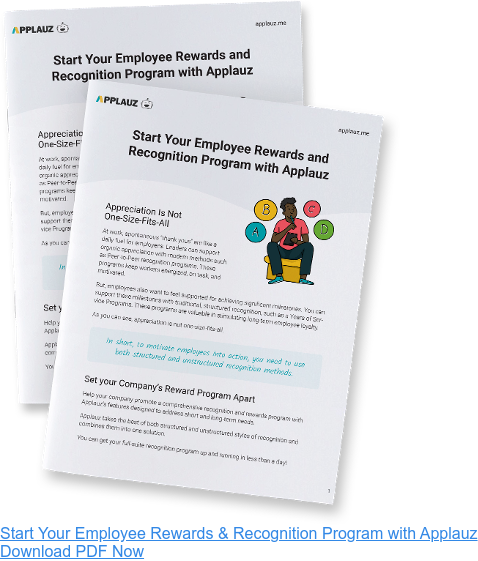The term “quiet quitting” went viral on TikTok in the summer of 2022 before making the headlines for months. It proved to be more than a fad – a Gallup report published in September 2022 revealed that at least half of the U.S. workforce was made up of quiet quitters.
Even though the word is being used less these days, the phenomenon that it represents is still very much a thing. Here’s what you need to know about quiet quitting and how to prevent it.
What is Quiet Quitting?
Quiet quitting refers to the idea of doing the bare minimum at work, meeting your job description requirements without going above and beyond. For some, it represents a rejection of hustle culture. For others, it’s a necessary approach to protect themselves from burnout or a way to avoid working more without extra pay. One thing is for sure: It’s a trend that should be on your radar if you manage people, because it isn’t going away.
The pandemic and the economic conditions that followed created the right conditions for quiet quitting to gain steam. Workers re-evaluated their relationships with the workplace amid lockdowns. Companies scrambled to pivot to remote and hybrid workplaces. The Great Resignation saw millions of employees actually quitting their jobs in droves, which disrupted the job market in favor of applicants.
Now, the cost of living crisis is affecting HR trends as well – people may be a little more reluctant to jump ship and a little more likely to quietly quit instead. Also, the sense of disengagement and dissatisfaction that manifested itself through the quiet quitting trend isn’t going to disappear just because there are fewer TikTok videos about it.
The Link Between Employee Recognition and Quiet Quitting
According to Gallup’s employee engagement tracker, only 34% of U.S. employees are engaged. Gallup uses surveys to measure different aspects of employee engagement, including employee recognition. Its latest data reveals a serious lack of regular employee recognition in the workplace – only 29% of respondents reported receiving recognition or praise for doing good work in the last seven days.
That lack of recognition may just be the hidden factor causing people to quietly quit. A DaVinci survey of professionals aged 18-38 revealed that 50% of younger workers believe that management does not recognize strong job performance and 67% are not satisfied with the investment their employer makes in rewards and recognition. Meanwhile,79% of respondents agreed that an increase in recognition rewards would make them more loyal to their employer.
According to Great Place to Work data, when all employees have an equal chance at getting recognized for their efforts, they are 2.2 times more likely to “flex their discretionary muscles and go above and beyond their regular duties.” And a genuine 'thank you' from senior leaders can lead to a 69% increase in the likelihood of employees bringing extra effort to work.
In other words, recognition is critical to keeping people engaged, especially when it comes to Gen Zers and millennials, who are only going to take up more space in the workforce in the years to come. As a manager, it is one of your best allies against quiet quitting.
Using Employee Recognition to Prevent Quiet Quitting
Wondering how to use employee recognition to prevent quiet quitting? The key is creating a culture of recognition – not just paying lip service to the concept.
To achieve this, look into building a comprehensive employee recognition program instead of leaving recognition up to chance. While your program can be customized based on the needs of your team and organization, it should include a few different types of recognition efforts for maximum impact, from celebrating big milestones and achievements to dishing out praise on a regular basis through communication platforms.
The right tech can then turn your employee recognition program into an effective system. For example, a platform like Applauz includes features such as Points and Badges to help you gamify the process of recognizing a job well done. It also offers tools to run employee surveys and optimize your recognition strategies based on data.
Peer-to-peer recognition works wonders for engagement too. “Being recognized by one’s peers can be just as meaningful as recognition that comes from the top down,” according to Great Place to Work. “It increases the number of opportunities for employees to receive recognition by widening the pool of potential recognizers and reinforces desired behaviors without resorting to explicit, top-down direction.”
What to Do If You Suspect an Employee of Quiet Quitting
Employee recognition can help you keep team members satisfied and motivated to bring their best to work – the exact opposite of quiet quitting. But it’s most effective as a preventative measure that fosters a positive workplace culture.
If you suspect that one of your reports has quietly quit, the best way to deal with the issue is head-on. You want to have an honest conversation about what’s going on and where there are gaps to bridge in terms of your employee’s needs. It’s important to initiate the conversation in a non-accusatory way. Create a safe space for the person to share concerns. Listen intently before jumping in to respond.
According to TeamBuilding.com, common factors behind a worker’s choice to quietly quit include excess workload, poor compensation, blurred work-life boundaries, a lack of manager support, unclear or shifting expectations, and poor communication or conflict resolution skills.
That one-on-one conversation may feel uncomfortable, but it can give you a wealth of insights about possible blind spots that may be leading others to consider quiet quitting. It also has the immediate effect of making your report feel heard and cared for, provided that you follow up the conversation with actual changes if changes are necessary.
Combining a genuine desire to create a healthy workplace culture with employee recognition strategies can work wonders for combatting quiet quitting. The best part? Productivity and retention will likely increase as a result of your intentional efforts.
About the author
Anouare Abdou
Anouare Abdou is a seasoned HR and business writer passionate about leadership, productivity, and the future of work. Her words have appeared in Business Insider, The Ladders, Thrive Global and more.




